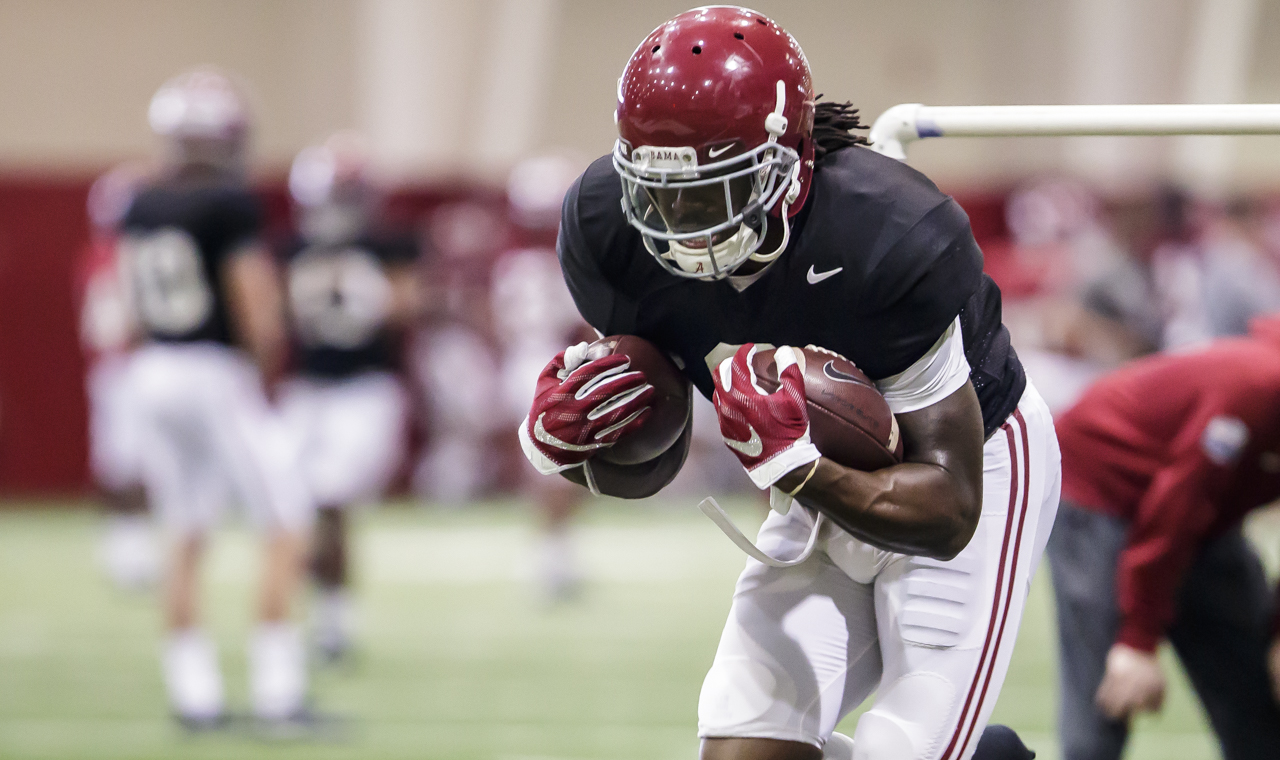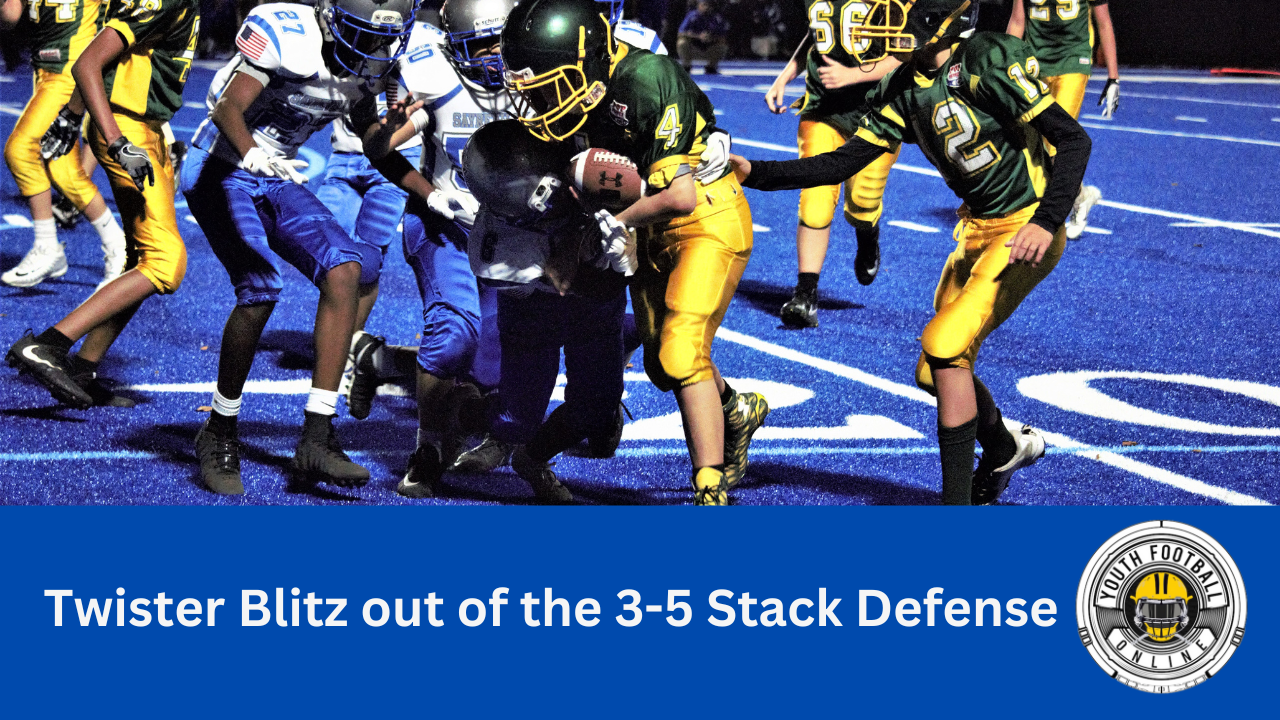Progression for Carrying the Football

The quickest way to lose a game at any level is to turn the ball over. This is why the number one rule for every offensive player is that at the end of the possession we have the ball. One way to help ensure this is by teaching, coaching and reinforcing proper ball security.
Progression for Carrying the Football
We teach ball security using the five points of pressure. With the five points of pressure the ball is completely protected from the defense. We use specific phrases for each of these five points that help illustrate the point, while also giving us coaching cues that we can use to correct poor technique quickly. The five points of pressure are eagle claw, lock the wrist, wrist above elbow, pin the ribs and double in trouble. Each of these phrases is a call to action that gives the players specific instructions and gives them a visual on how to carry the ball.
Eagle Claw
One mistake rookie players will make is to cover the tip of the ball, or even worse carry the ball upright. If a player is using the eagle claw there is no way they can make either of these mistakes. The Eagle Claw is when the ball carrier grabs the tip of the ball by not covering the tip. This prevents the ball carrier from carrying the ball vertically which eliminates the first rookie mistake players make. The Eagle Claw is effective because it does not cover the tip of the ball. By covering the tip of the ball the ball carrier is exerting pressure on a small surface area. When they spread their hand out and put pressure through all of the fingers the pressure is spread over a wider area which makes it less susceptible to a direct hit from a defender.
Lock the Wrist
Another common mistake players will make is to pin the ball directly to their chest without locking their wrist. The effect is that there is an open space between the ball carrier’s arm and the ball. This is space that can allow the ball to wiggle out in contact or for a defender’s hand to slip in to rip the ball out. Instead it’s critical that the ball carrier Locks his Wrist. The effect of this is that the ball is now tight against the forearm. This gives a wide surface area for the player to apply pressure to secure the ball and also helps to protect the ball from defender’s hands.
Wrist Above Elbow
One of the most under coached parts of ball security is the Wrist Above Elbow portion of ball carrying. The idea behind Wrist Above Elbow is that the ball carrier will keep his wrist above his elbow the whole time he has the ball. By keeping his wrist above his elbow he creates a bend in the arm. This bend allows the player’s bicep to cover the ball opposite of the forearm. Again there is a large surface area where the player can exert pressure on the ball to help secure it. The added benefit with keeping the wrist above the elbow is that is protects the back end of the ball. One of the more common causes of fumbles is when the ball carrier has the ball poked out from behind. This occurs when the ball carrier does not have his wrist higher than his elbow, this takes away his bicep as the backside protection and opens the ball up to a chasing defender
Pin the Ribs
The most underrated coaching point of ball security is to pin the ball to the ribs. By pinning the ball against his ribs the ball carrier can protect the backside of the ball. This is an excellent way to secure possession. The area where players tend to forget about pinning the ball to their ribs is when they begin to change directions. The body will naturally throw the arm out to counter the change of direction. It’s important that players drill this and work on keeping the ball in tight against their upper body to stop the body from putting the arm out automatically.
Double in Trouble
The last point of protection is the second arm across the ball. By putting the second arm across the ball the ball now has an added security that one arm alone cannot provide. It also has the added effect of narrowing the shoulder frame of the runner and making it easier to get through a narrow hole. This, combined with the body’s natural tendency to lower the shoulder level when doubling over the ball, creates a runner with a low center of gravity that can get through a narrow hole.
By doubling the ball up the runner has almost guaranteed possession of the ball but he cannot run very fast. As a result we tell our runners to only double the ball when they are going through the hole or into immediate contact, which creates the phrase double in trouble. With that being said it’s always better that the runner airs on the side of caution and securing the ball.
The turnover battle is the number one predictor of who will win any football game, regardless of the level. It’s important that players know how to properly secure possession and it is drilled on a daily basis.
Progression for Carrying the Football
- Eagle Claw
- Lock the Wrist
- Wrist Above Elbow
- Pin the Ribs
- Double in Trouble
- High and Tight
Make it clear to your skilled position players- that if they can’t secure the football they will not be carrying the football. Fumbles cannot happen.
(See Also) Running Back Drills
(See Also) Coaching Running Backs










